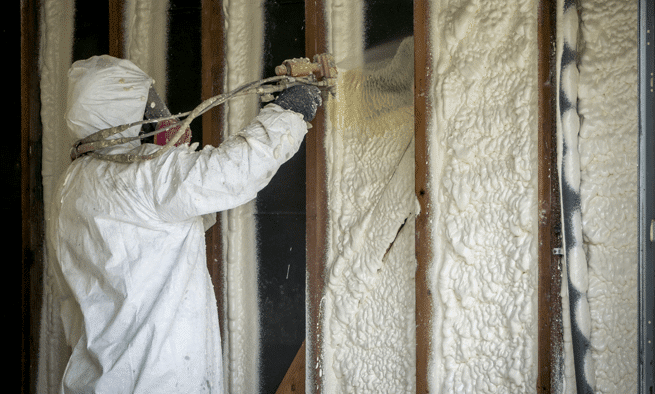TDI and MDI – or Toluene Diisocyanate and Methylene Diphenyl Diisocyanate – are two of the most common chemicals associated with the polyurethane industry. Diisocyanate monitoring is top of mind when it comes to these two. These chemicals are the building blocks for all kinds of plastics, foams, and other materials used in countless everyday products.
But this blog isn’t about their use in products or the intricate processes used to tame these wildly named compounds. We’re here to talk about the unsung hero of spray foam jobs—the assistant. The one whose exposure to MDI often flies under the radar. The people who, without them, jobs wouldn’t run smoothly and workplaces wouldn’t be nearly as fun.
MDI in the spray foam industry
Let’s do a quick recap of spray foam and how MDI fits into the process (for more in-depth polyurethane safety info, check out our blog on the topic). MDI is like the secret ingredient that makes spray foam insulation so awesome! When it teams up with a polyol, it creates that magical expanding foam that keeps buildings warm, cozy, and energy-efficient.
That’s the simplest explanation, but the point is: MDI is ever-present and critical in spray foam. Now, if you’ve ever had spray foam insulation installed, you’ve likely seen the gear that operators wear. It’s basically a hazmat suit—head-to-toe PPE, including gloves, shoe covers, a full suit, and a SCBA (Self-Contained Breathing Apparatus). Basically what you’d imagine someone wearing into a clean-room…they’re covered. And they wear it for good reason!
The effects of MDI exposure
Inhalation of aromatic diisocyanates like MDI can irritate the respiratory system, while skin contact can cause irritation. Chronic overexposure has been linked to lung damage, including fibrosis. Even more concerning, MDI and TDI are known respiratory sensitizers—meaning repeated exposure or even a single large dose can cause long-term sensitivity in some individuals.
Let’s talk the assistants.
Now here’s the real focus. While operators are fully suited up and well-protected, there are often others on-site who aren’t. Assistants supporting spray foam operations typically aren’t present during the actual spraying, so they may not be as heavily equipped with PPE. But that doesn’t mean they’re safe from exposure.
At Morphix, we’ve heard from many customers using our SafeAir TDI/MDI badges for assistants on spray foam jobs and using these for diisocyanate monitoring. These team members might only pop into the work area briefly to deliver supplies or double-check something—but those “few seconds” can add up.
How can this exposure really play out?
The danger of thinking “it’s just a few seconds” is that there could be countless exposures over the course of a project. And if those exposures go unmonitored, there’s no way to know the cumulative risk. Sensitization is tricky—it can develop silently and lead to more serious health issues down the line. All the more reason to take even short-term exposure seriously.
What’s the solution? Diisocyanate Monitoring.
Our customers consistently tell us they use the SafeAir TDI/MDI badge to track exposure levels for assistants and others near spray zones. While electronic detectors offer real-time monitoring, they’re expensive, require regular calibration, and often aren’t practical for brief exposures.
The SafeAir TDI/MDI Chemical Detection Badge offers a simple, cost-effective solution. It’s easy to wear, doesn’t require complex training, and provides visual confirmation of exposure levels. Spray foam companies—many of which are small operations—use these badges to protect every member of the team, regardless of their role. Because when it comes to workplace safety, no one should be an afterthought.
SafeAir TDI/MDI Badges: Putting People First in Spray Foam Safety
While much of the focus in spray foam safety centers on the operator and the spraying process, it’s equally important to consider the exposure risks for everyone else on-site. Assistants, helpers, and team members who support spray foam operations may not spend time directly in the application zone, but they’re still vulnerable to chemical exposure—especially to aromatic diisocyanates like MDI and TDI.
This is where the SafeAir TDI/MDI badge offers a critical safety solution to diisocyanate monitoring . Unlike costly electronic detectors, these badges are affordable, easy to use, and ideal for short-term exposure monitoring. They’re worn in the breathing zone and provide a clear, visual indication of exposure levels, helping both managers and workers stay informed and protected. The SafeAir TDI/MDI Chemical Detection badges detect the presence of TDI or MDI at 5ppb·hr and can be used in conjunction with their corresponding color comparator(s) to offer an extended range of 5-140 ppb·hr.
In the end, it’s not just about compliance; it’s about care. It’s about recognizing that everyone on a jobsite matters, and every exposure—no matter how small—deserves attention. The SafeAir badge is more than a safety tool. It’s a statement: that in this industry, people come first.
Contact us to learn more about this badge or check out our product page for more details or our Amazon Storefront to place an order
